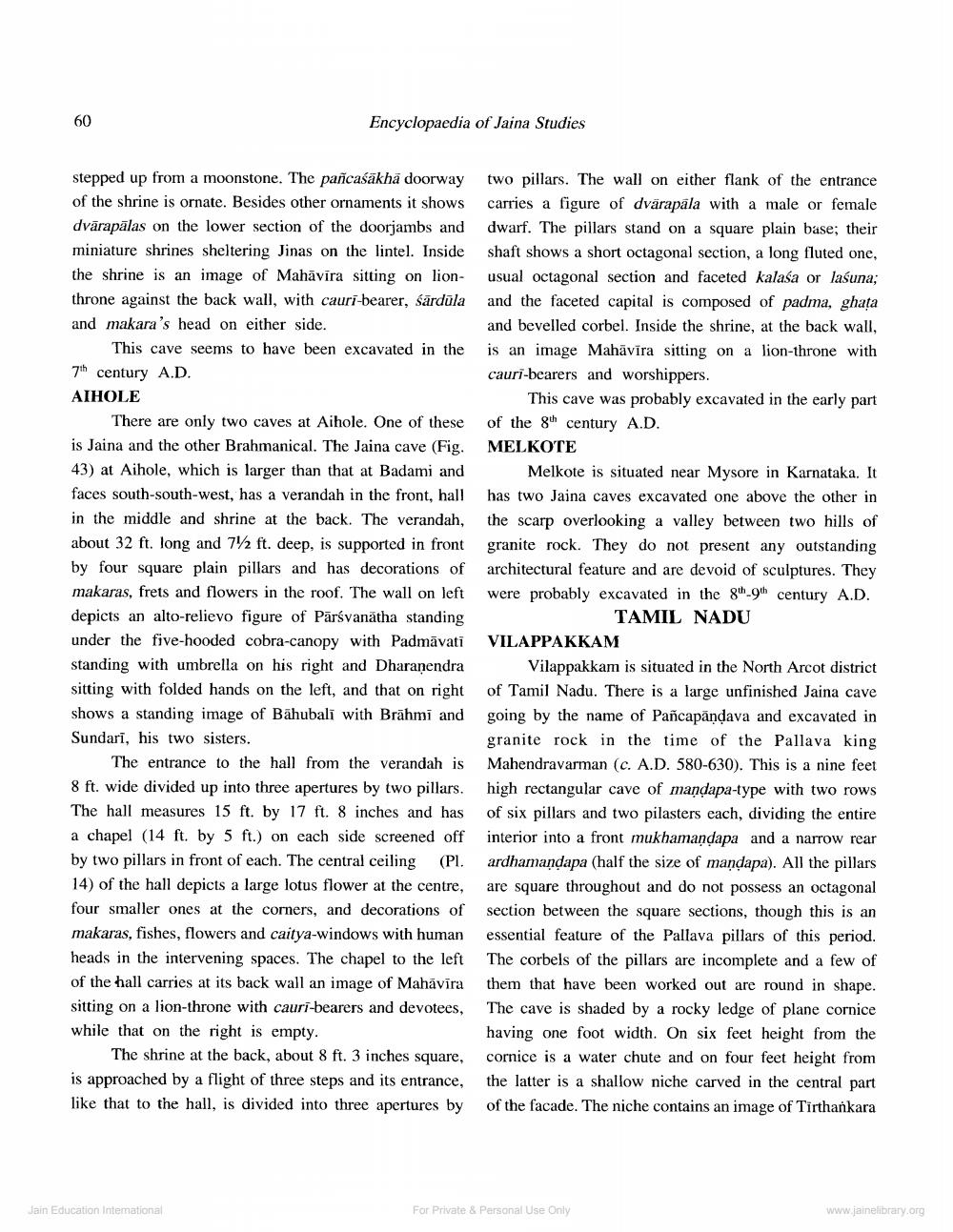________________
60
Encyclopaedia of Jaina Studies
stepped up from a moonstone. The pañcaśākhá doorway two pillars. The wall on either flank of the entrance of the shrine is ornate. Besides other ornaments it shows carries a figure of dvärapala with a male or female dvārapālas on the lower section of the doorjambs and dwarf. The pillars stand on a square plain base; their miniature shrines sheltering Jinas on the lintel. Inside shaft shows a short octagonal section, a long fluted one, the shrine is an image of Mahāvīra sitting on lion- usual octagonal section and faceted kalasa or lasuna; throne against the back wall, with cauri-bearer, śārdūla and the faceted capital is composed of padma, ghata and makara's head on either side.
and bevelled corbel. Inside the shrine, at the back wall, This cave seems to have been excavated in the is an image Mahāvīra sitting on a lion-throne with 7th century A.D.
cauri-bearers and worshippers. AIHOLE
This cave was probably excavated in the early part There are only two caves at Aihole. One of these of the 8th century A.D. is Jaina and the other Brahmanical. The Jaina cave (Fig. MELKOTE 43) at Aihole, which is larger than that at Badami and Melkote is situated near Mysore in Karnataka. It faces south-south-west, has a verandah in the front, hall has two Jaina caves excavated one above the other in in the middle and shrine at the back. The verandah, the scarp overlooking a valley between two hills of about 32 ft. long and 7/2 ft. deep, is supported in front granite rock. They do not present any outstanding by four square plain pillars and has decorations of architectural feature and are devoid of sculptures. They makaras, frets and flowers in the roof. The wall on left were probably excavated in the 80-90h century A.D. depicts an alto-relievo figure of Pārsvanätha standing
TAMIL NADU under the five-hooded cobra-canopy with Padmāvati VILAPPAKKAM standing with umbrella on his right and Dharanendra Vilappakkam is situated in the North Arcot district sitting with folded hands on the left, and that on right of Tamil Nadu. There is a large unfinished Jaina cave shows a standing image of Bahubali with Brāhmi and going by the name of Pañcapāņdava and excavated in Sundarī, his two sisters.
granite rock in the time of the Pallava king The entrance to the hall from the verandah is Mahendravarman (c. A.D. 580-630). This is a nine feet 8 ft. wide divided up into three apertures by two pillars. high rectangular cave of mandapa-type with two rows The hall measures 15 ft. by 17 ft. 8 inches and has of six pillars and two pilasters each, dividing the entire a chapel (14 ft. by 5 ft.) on each side screened off interior into a front mukhamandapa and a narrow rear by two pillars in front of each. The central ceiling (Pl. ardhamandapa (half the size of mandapa). All the pillars 14) of the hall depicts a large lotus flower at the centre, are square throughout and do not possess an octagonal four smaller ones at the corners, and decorations of section between the square sections, though this is an makaras, fishes, flowers and caitya-windows with human essential feature of the Pallava pillars of this period. heads in the intervening spaces. The chapel to the left The corbels of the pillars are incomplete and a few of of the hall carries at its back wall an image of Mahāvīra them that have been worked out are round in shape. sitting on a lion-throne with cauri-bearers and devotees, The cave is shaded by a rocky ledge of plane cornice while that on the right is empty.
having one foot width. On six feet height from the The shrine at the back, about 8 ft. 3 inches square, cornice is a water chute and on four feet height from is approached by a flight of three steps and its entrance, the latter is a shallow niche carved in the central part like that to the hall, is divided into three apertures by of the facade. The niche contains an image of Tirthankara
Jain Education Intemational
ducation International
For Private & Personal Use Only
For Private & Personal Use Only
www.jainelibrary.org




